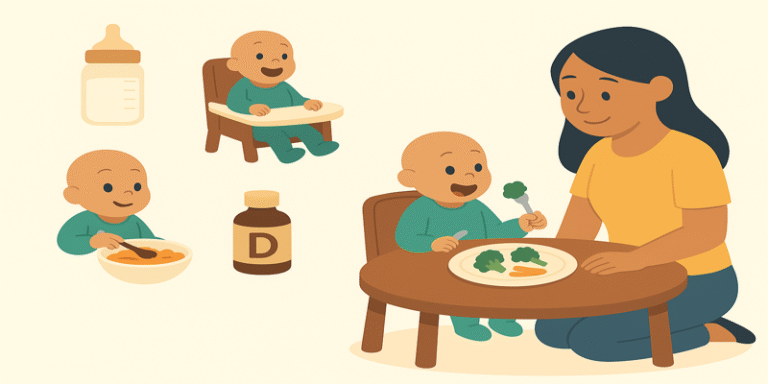The period between one and three years of age is a transformative time in a child’s life. Not only do children grow rapidly, but they also begin to form habits that may influence their long-term health. Developing healthy eating habits during this window is therefore crucial. While children at this age are increasingly independent, they still rely on caregivers to provide nurturing environments, structure, and good dietary examples (Wardle et al., 2003).
This article explores the nutritional needs, feeding practices, and behavioural strategies that support healthy eating in toddlers aged one to three.
1.0 Nutritional Needs of Toddlers
Toddlers need energy-dense, nutrient-rich foods to support their rapid physical and cognitive development. While their appetite can vary from day to day, offering a balanced diet ensures they receive essential nutrients.
1.1 Macronutrients:
- Carbohydrates should make up around 50% of their energy intake, providing fuel for daily activity and brain development. Sources include wholemeal bread, oats, potatoes, and rice (NHS, 2023a).
- Protein is essential for muscle development and tissue repair. Toddlers should consume two portions daily from sources such as eggs, lentils, poultry, fish, or tofu (British Dietetic Association, 2023).
- Fats, particularly unsaturated fats, are crucial for brain growth. Healthy sources include full-fat dairy, avocados, and oily fish like salmon.
1.2 Micronutrients:
- Iron is vital to prevent anaemia and support learning. Red meat, fortified cereals, and dark green leafy vegetables are excellent sources (Fewtrell et al., 2017).
- Calcium is needed for bone development. Toddlers require about 350 mg of calcium daily, which can be met through milk, cheese, and yoghurt (First Steps Nutrition Trust, 2022).
- Vitamin D is essential for calcium absorption and immune function. Since sunlight exposure may be inadequate, toddlers should receive a daily 10μg vitamin D supplement (SACN, 2020).
2.0 Transitioning to Family Meals
Between 12 and 36 months, children transition from baby foods to family meals. Offering a variety of textures, flavours, and colours builds acceptance and helps prevent fussy eating.
2.1 Family-style meals
Eating together encourages children to copy healthy behaviours and promotes social and language skills (Scaglioni et al., 2018). Meals should be regular, ideally three main meals and two snacks per day.
2.2 Portion control
Appropriate portion sizes help avoid overfeeding. A toddler’s portion is typically a third to half of an adult’s. Caregivers should trust the child’s ability to self-regulate hunger.
2.3 Consistency in routines
Establishing mealtime routines – such as eating at the same time and in the same place – helps reduce anxiety and sets clear expectations (Rapley & Murkett, 2010).
3.0 Encouraging Positive Food Behaviours
Picky eating, food refusal, and mealtime tantrums are common in toddlers. These are part of normal development but can be managed with a patient and consistent approach.
3.1 Offer variety, not pressure
Introducing a wide range of foods, even those initially rejected, helps expand dietary preferences. Studies show it may take 10–15 exposures before a toddler accepts a new food (Carruth & Skinner, 2000).
3.2 Model healthy eating
Children imitate adult behaviours. Parents and carers who enjoy fruits, vegetables, and home-cooked meals can foster similar preferences in children (Savage et al., 2007).
3.3 Avoid food as a reward
Using sweets as bribes reinforces unhealthy associations. Praise and encouragement for trying new foods are more effective in the long term.
3.4 Minimise distractions
Turn off televisions and mobile devices during meals to allow toddlers to focus on eating and communicating (Hiniker et al., 2016).
4.0 Managing Snacks and Drinks
Snacks play a key role in providing energy and nutrients between meals. However, they must be nutritious rather than indulgent.
4.1 Healthy snack ideas:
- Fruit slices with yoghurt
- Vegetable sticks with hummus
- Wholegrain crackers with cheese
- Rice cakes with mashed banana
Avoid high-sugar snacks, crisps, and sugary drinks, which can contribute to obesity and tooth decay (Public Health England, 2020).
4.2 Hydration
Water and plain milk are the best choices. Fruit juices, if offered, should be well-diluted (1 part juice to 10 parts water) and only at mealtimes to minimise sugar exposure (NHS, 2023b).
5.0 Supplements and Special Considerations
5.1 Vitamin supplements
The NHS recommends daily vitamin drops containing vitamins A, C, and D for children aged one to five, unless they drink more than 500ml of formula milk per day (NHS, 2023c).
5.2 Special diets
For vegetarian or vegan children, extra attention should be paid to iron, vitamin B12, protein, and omega-3 fatty acids. Consulting a registered dietitian ensures balanced nutrition (Craig et al., 2009).
6.0 Building Lifelong Habits
The toddler years are ideal for creating routines that promote healthy eating for life.
6.1 Involve children in food prep
Allowing toddlers to help wash vegetables, stir batter, or assemble simple snacks increases their interest in food and builds fine motor skills.
6.2 Use child-sized utensils and furniture
A toddler-sized spoon, cup, and chair make mealtimes more manageable and enjoyable.
6.3 Mealtime atmosphere
Avoid battles and maintain a calm, supportive tone. Even if a child eats little at one meal, they typically make up for it at another.
Developing healthy eating habits from ages one to three is one of the most impactful steps parents and carers can take to support lifelong well-being. At this stage, children are forming food preferences, learning social norms, and developing the physical ability to feed themselves.
Caregivers should focus on offering nutrient-rich, varied meals in a supportive setting without pressure. Modelling behaviour, routine, and positive reinforcement are the keys to success. Seeking guidance from healthcare providers when concerns arise ensures each child receives the individualised care they deserve.
References
British Dietetic Association (2023) Healthy Eating for Children Aged 1 to 3. [Online] Available at: https://www.bda.uk.com/ [Accessed 12 June 2024].
Carruth, B.R. & Skinner, J.D. (2000) Feeding Behaviors and Other Motor Development in Healthy Children. Journal of the American College of Nutrition, 19(6), pp. 586–592.
Craig, W.J., Mangels, A.R. & American Dietetic Association (2009) Position of the American Dietetic Association: Vegetarian Diets. Journal of the American Dietetic Association, 109(7), pp. 1266–1282.
Fewtrell, M. et al. (2017) Complementary Feeding: A Position Paper by the European Society for Paediatric Gastroenterology Hepatology and Nutrition. Journal of Pediatric Gastroenterology and Nutrition, 64(1), pp. 119–132.
First Steps Nutrition Trust (2022) Eating Well: The First Year. [Online] Available at: https://www.firststepsnutrition.org [Accessed 12 June 2024].
Hiniker, A., Schoenebeck, S. & Kientz, J.A. (2016) Not at the Dinner Table: Parents’ and Children’s Perspectives on Family Technology Rules. CSCW, pp. 1374–1387.
NHS (2023a) What to Feed Young Children. [Online] Available at: https://www.nhs.uk/start-for-life/baby/weaning/ [Accessed 12 June 2024].
NHS (2023b) Food and Drinks to Avoid Giving Babies and Young Children. [Online] Available at: https://www.nhs.uk [Accessed 12 June 2024].
NHS (2023c) Vitamins for Children. [Online] Available at: https://www.nhs.uk/conditions/baby/weaning-and-feeding/vitamins-for-children/ [Accessed 12 June 2024].
Public Health England (2020) Change4Life Campaign: Healthier Snacks. [Online] Available at: https://www.nhs.uk/change4life [Accessed 12 June 2024].
Rapley, G. & Murkett, T. (2010) Baby-led Weaning: Helping Your Baby to Love Good Food. Vermilion.
SACN (2020) Vitamin D and Health Report. [Online] Available at: https://www.gov.uk/government/groups/scientific-advisory-committee-on-nutrition [Accessed 12 June 2024].
Savage, J.S., Fisher, J.O. & Birch, L.L. (2007) Parental Influence on Eating Behavior: Conception to Adolescence. The Journal of Law, Medicine & Ethics, 35(1), pp. 22–34.
Scaglioni, S. et al. (2018) Factors Influencing Children’s Eating Behaviours. Nutrients, 10(6), 706.
Wardle, J. et al. (2003) Parental Feeding Style and the Inter-Generational Transmission of Obesity Risk. Obesity Reviews, 4(2), pp. 121–130.









